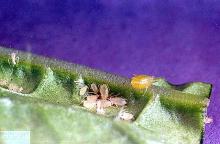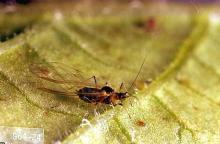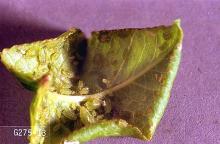Includes
Green peach aphid (Myzus persicae)
Lettuce aphid (Nasonovia ribis-nigri)
Pest description and crop damage Small yellowish, soft-body insect. Aphids suck plant sap from foliage causing a yellowing or wilting of the plant and sticky "honeydew" exudates. Green peach aphid infestations start on the lower leaves of the plant and move upward. Green peach aphids can vector several viruses that affect lettuce including alfalfa mosaic, beet western yellows, beet yellow stunt, and turnip mosaic. If green peach aphid develops in high numbers on seedlings, apply insecticide as soon as plants appear stressed. On more mature plants, do not apply insecticide unless numbers exceed 20 aphids per plant. Lettuce aphid on the other hand feeds from the inside out, starting with young leaves and works it way out to older material. It is distinguished from peach aphid because of the lack of converging antennal tubercles. Lettuce aphid is not the primary vector of other viruses and diseases.
Management-chemical control
Begin applications at first sign of infestation. Multiple applications with thorough coverage are necessary for effective control.
- azadirachtin (Neemix 4.5) at 5 to 7 fl oz /A (0.015 to 0.021 lb ai/A). PHI 0 days. REI 4 hr. Suppression and adult feeding deterrence. Apply every 7 to 10 days or as needed. Some formulations are OMRI-listed for organic production.
- pymetrozine (Fulfill) at 2.75 oz/A product (0.086 lb ai/A). PHI 7 days. REI 12 hr. Do not exceed 5.5 oz/A product (0.172 lb ai/A) per season. Apply when aphids first appear, before populations build to damaging levels. Affected aphids will stop feeding on the plant shortly after exposure, but may remain on the plant until they die, which is usually within 2-4 days. Use a minimum of 5 gal water/A when applied by air and a minimum of 10 gal water/A when applied by ground. Two applications may be needed to control persistent aphid populations. Allow at least 7 days between applications. SLN WA-190003 for Adama Fulfill products (expires 12/31/2024). Washington only. In Washington, when crops or broadleaf weeds are blooming, apply between late evening and early morning only (between 6PM and 7AM).



